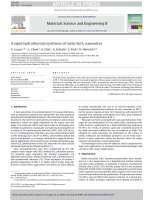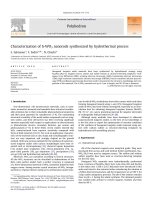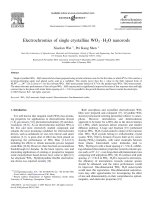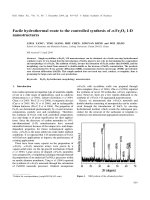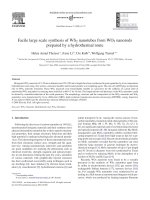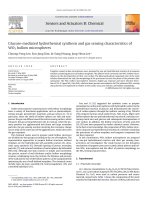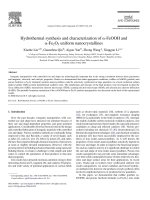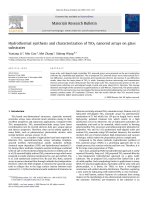- Trang chủ >>
- Khoa Học Tự Nhiên >>
- Vật lý
hydrothermal synthesis of monodisperse wo3 - h2o square platelet particles
Bạn đang xem bản rút gọn của tài liệu. Xem và tải ngay bản đầy đủ của tài liệu tại đây (495.73 KB, 3 trang )
Hydrothermal synthesis of monodisperse WO
3
·H
2
O square platelet particles
Fumiyuki Shiba
a,
⁎
, Masakazu Yokoyama
a
, Yousei Mita
b
,
Tomohiro Yamakawa
b
, Yusuke Okawa
a
a
Graduate School of Science and Technology, Chiba University, Yayoicho 1-33, Inageku, Chiba 263-8522, Japan
b
Faculty of Engineering, Chiba University, Yayoicho 1-33, Inageku, Chiba 263-8522, Japan
Received 11 July 2006; accepted 22 July 2006
Available online 15 August 2006
Abstract
Monodisperse particles of tungsten(VI) oxide monohydrate were prepared in a hydrothermal system at 40 °C, where 20 ml of HCl solution
(1.50 mol/l) was added to the same volume of Na
2
WO
4
aqueous solution (0.50 mol/l) with magnetic stirring, followed by standing in an air oven
for 168 h. The shape of the particles was square platelet and the mean size was 0.72 μm with 10% of the coefficient of variation. The XRD pattern
was in good agreement with the standard JCPDS data for WO
3
·H
2
O. The effects of counter cation and anion of the starting materials in addition to
the preparation temperature and acid concentration were also examined.
© 2006 Elsevier B.V. All rights reserved.
Keywords: Tungsten(VI) oxide monohydrate; Tungstic acid; Monodisperse particle; Hydrothermal synthesis
1. Introduction
Tungsten(VI) oxide and its hydrates, WO
3
·nH
2
O, are known
as electrochromic (EC) substances which alternate their color by
electrochemical redox reactions. A deep blue color in the
reduced state is based on a mixed valence state of W(V) and W
(VI) [1]. Thin films, prepared by vapor evaporation for instance,
are common in the WO
3
-based EC devices [2]. However, if
particulate materials are applied, availabilities such as simple
production processes and hybrid compositions with functional
polymers [3,4] are expected. In addition, printing processes are
applicable for patterning of the EC materials. Monodisperse
particles are particularly expected to give sharp distributions of
properties such as response time, precise controls of properties,
regular arrangement of particles on electrode, etc.
Hydrothermal synthesis from Na
2
WO
4
in a low pH region is
one of the typical ways to prepare tungsten oxide hydrates.
Freedman [5] investigated influence of acid concentration and
temperature on preparation of WO
3
·H
2
O and WO
3
·2H
2
O from
Na
2
WO
4
solution. Gerand et al. [6] prepar ed WO
3
·1 / 3H
2
Oin
pure water at 120 °C by digesting washed precipitates of
WO
3
·nH
2
O gel or particles, preliminarily prepared from
Na
2
WO
4
in acidic conditions. Instead of adding acid solution s,
an ion-exchange method was also applied to make Na
2
WO
4
solution acidic to prepare the WO
3
·2H
2
O particles [7]. How-
ever, there seems to be few reports on narrowing the size
distribution of these particles. In the present study, the hydro-
thermal condition was optimized to prepare monodisperse
WO
3
·H
2
O parti cles.
2. Experimental
In the standard condition, 0.50 mol/l of Na
2
WO
4
solution
was freshly prepared by dissolving 3.30 g of Na
2
WO
4
·2H
2
Oin
20 ml of distilled water in a screw-capped bottle. At 40 °C,
20 ml of HCl aqueous solution (1.50 mol/l) was added into the
Na
2
WO
4
solution by a transfer pipette under magnetic stirring,
which was halted after 1 min from mixing. After 168 h of
storage in an air oven at 40 °C, the precipitates were centrifuged
at 2000 rpm for 15 min. After removing the supernatant
solution, they were re-dispersed in distilled water and
centrifuged again. Five sets of the centrifugation process were
carried out to wash completely.
The effects of the preparation condition were examined by
varying either HCl concentration or temperature from the
Materials Letters 61 (2007) 1778 – 1780
www.elsevier.com/locate/matlet
⁎
Corresponding author. Fax: +81 43 290 3490.
E-mail address: (F. Shiba).
0167-577X/$ - see front matter © 2006 Elsevier B.V. All rights reserved.
doi:10.1016/j.matlet.2006.07.129
standard condition. Also, the influence of counter ions of the
starting materials was tested. That is, Li
2
WO
4
and K
2
WO
4
were
used instead of Na
2
WO
4
. Alternatively, HCl was replaced by
HClO
4
, HNO
3
,orH
2
SO
4
. Because Li
2
WO
4
did not dissolve in
distilled water, it was used in a form of dispersion.
Particle shape was observed by a scanning electron micro-
scope (SEM, Hitachi S-2400). The mean size and coefficient of
variation, COV, were obtained with a transmission electron
microscope (TEM, JEOL JEM-1200EX). The particles were
identified by X-ray diffractometry (XRD) using CuKα radiation
with MacScience M18XHF-SRA. The yield of the objective
particles was estimated by a gravimetric analysis, in which
precipitates fairly separated from soluble salts and gel-like
residuals were heated to dehydrate at 750 °C for 30 min and
then weighed as WO
3
. All chemicals were purchased from
Wako Pure Chemicals except for Li
2
WO
4
which was purchased
from Aldrich. They were used as supplied.
3. Results and discussion
Particles prepared in the standard condition were in square platelet
shape from SEM images, as shown in Fig. 1. Fig. 1 also indicates a
histogram of their size distribution obtained from TEM observation.
The mean edge length was estimated as 0.72 μm with 10% in COV
from more than 200 particles. The average thickness was about 0.2 μm.
Fig. 1. SEM image of obtained particles in the standard condition and their size
distribution evaluated from TEM observations.
Fig. 2. XRD patterns of (a) particles obtained in the standard condition and
(b) standard of WO
3
·H
2
O on the basis of JCPDS data (JCPDS No. 18-1418).
Fig. 3. Time evolutions of (a) the mean size of particle and COV and corres-
ponding TEM images at (b) 48 h, (c) 56 h, (d) 96 h, and (e) 168 h in the standard
condition with the limited repetition of centrifugal washing.
1779F. Shiba et al. / Materials Letters 61 (2007) 1778–1780
The particles were identified as tungsten(VI) oxide monohydrate by a
good agreement in the XRD pattern with a JCPDS data for WO
3
·H
2
O
(JCPDS No.18-1418) as shown in Fig. 2. The crystal structure of
WO
3
·H
2
O is anisotropic, where layers consisting of Wand O atoms are
stacked via hydrogen bonds [8]. As explained by Livage and Guzman
[9], the W atom in the precursor has four coordinated OH groups in an
equatorial xy plane with a W_O bond and water molecule in the
vertical z-axis. The platelet shape of particles suggests a large dif-
ference in the growth rates of the crystal orientations depending on the
precursor structure.
The change of appearance during the formation process was as
follows. At first, a yellow transparent solution was formed by mixing of
the Na
2
WO
4
and HCl solutions due to formation of soluble complexes.
The mixed solution soon became turbid by the generation of gel-like
precipitates and lost fluidity within a few minutes. Reflecting the
decrease of complexes, the yellowish color was once reduced until 48 h
but gradually increased again by growth of WO
3
·H
2
O particles, which
are also yellow. The apparent volume of precipitate started to decrease
at ∼ 72 h and reached to ca. 1 / 3 of the whole volume at 168 h.
Fig. 3 shows time evolutions of the mean edge length of objective
particles and COV with some corresponding TEM images at 48, 56, 96,
and 168 h, where the results were obtained from precipitates discretely
prepared for each time. Besides, the repetition of centrifugal washing
was limited to two times to retain the gel-like precipitates. Only gel was
observed before 48 h but objected particles were formed in the gel-
network at least at 56 h. Fig. 3(a) suggests ongoing particle growth
even at 168 h. In addition, the gel-like precipitates seemed amorphous
in the earlier stage of the generation process and somewhat crystalline
at 168 h from dark-field observations with TEM. The standard
deviation of particle size was almost constant (ca. 0.07 μm) during the
growth period. Thus COV tended to decrease from 22% at 56 h to 10%
at 168 h.
Due to the gel-like residuals existing at the end of precipitation, as
shown in Fig. 3(e), the yield of the objective particles was unfortunately
low as 25%. It was raised to 75% by using Li
2
WO
4
instead of Na
2
WO
4
,
although particles were polydisperse ones with about 0.4 μm and 25%
in mean size and COV, respectively. K
2
WO
4
generated only gel-like
precipitates without any objective particles. Moreover, when the
concentration of Na
2
WO
4
solution was reduced to 0.1 mol/l, coupled
with 0.85 mol/l of HCl, the yield was raised to 80% with a declined
monodispersity (12% in COV with 0.46 μm in the mean size). Univalent
acids, HClO
4
and HNO
3
, gave almost the same results as that of HCl.
On the contrary, H
2
SO
4
formed only gel-like precipitates. Balázsi and
Pfeifer [10] observed structural and morphological changes of
WO
3
·2H
2
O particles by a decrease of Na
+
ion content through a re-
peated washing treatment. Therefore, counter ions of tungstates and
acids anyway play important roles on the formation process in this
system, although the mechanism has not been clear yet.
The effect of the concentration of HCl solution was tested in the
range of 1.40–1.80 mol/l at 40 °C with Na
2
WO
4
. When increasing the
HCl concentration, the mean size was reduced from 0.95 to 0.62 μm
and COV tended to decline from 10% to 19%. When temperature was
varied in 35–55 °C with 1.50 mol/l of HCl solution, the mean size was
decreased from 0.80 to 0.59 μm by the increasing temperature. A
minimum COV was shown at 40 °C (20, 10, 13, 12, and 15% in COVat
35, 40, 45, 50, and 55 °C, respectively). Except for 35 °C, the apparent
volumes of yellow precipitates at 168 h were almost the same as that of
the standard condition (40 °C), suggesting similar yields in these
conditions since the apparent volume reflects a degree of transforma-
tion to the WO
3
·H
2
O particles from bulky gels. At 35 °C, the apparent
volume of the precipitate was almost the same as that of the whole
volume. The larger mean size at 35 °C, even the small conversion to
WO
3
·H
2
O, is due to an inhibited nucleation. Hence this temperature is
likely a critical one to form WO
3
·H
2
O in the system. This observation
may be supported by the results of Freedman [5], who has reported that
only WO
3
·2H
2
O was obtained at 25 °C while mixtures of WO
3
·H
2
O
and WO
3
·2H
2
O were obtained at 50 °C.
Generally in monodisperse particle preparations, monodispersity
indicated by COV is narrowed by the progress of growth with at least a
constant absolute size distribution [11]. Thus longer growth periods
relative to nucleation ones are preferred in addition to a clear separation
of both steps. In agreement with the mechanisms, COV in the standard
condition was decreased to reach the monodisperse particles with the
almost constant standard deviation and increasing particle size, as
mentioned above. Hence size distribution at the end of the nucleation
period has an importance in the final monodispersity. In other words,
higher HCl concentration and higher temperature than the standard
condition kept a high supersaturation ratio to advance the nucleation
period, giving smaller size and declined monodispersity in the present
system.
4. Conclusions
Monodisperse WO
3
·H
2
O particles in a square platelet shape
were prepared in an optimized hydrothermal system. The narrow
size distribution, 10% in COV with 0.72 μm in mean size, was
achieved in the standard condition.
Acknowledgement
We would like to thank Dr. T. Kojima (Department of Applied
Chemistry and Biotechnology, Chiba University) for the XRD
measurements and Mr. Y. Funabashi (Department of Information
and Image Sciences, Chiba University) for the SEM observa-
tions. The research was partially supported by the Ministry of
Education, Science, Sports and Culture, Grant-in-Aid for Young
Scientists (B) and by the Hosokawa Powder Technology
Foundation.
References
[1] M.B. Robin, P. Day, Adv. Inorg. Chem. Radiochem. 10 (1967) 247.
[2] B.W. Faughan, R.S. Crandall, Display Devices, in: J.I. Pankove (Ed.),
Springer, Berlin, 1980, Chapter 5.
[3] H. Yoneyama, S. Hirano, S. Kuwabata, J. Electrochem. Soc. 139 (1992)
3141.
[4] F. Michalak, P. Aldebert, Solid State Ionics 85 (1996) 265.
[5] M.L. Freedman, J. Am. Chem. Soc. 81 (1959) 3834.
[6] B. Gerand, G. Nowogrocki, M. Figlarz, J. Solid State Chem. 38 (1981)
312.
[7] Y G. Choi, G. Sakai, K. Shimanoe, N. Miura, N. Yamazoe, Sens.
Actuators, B, Chem. 87 (2002) 63.
[8] J.T. Szymański, A.C. Roberts, Can. Mineral. 22 (1984) 681.
[9] J. Livage, G. Guzman, Solid State Ionics 84 (1996) 205.
[10] Cs. Balázsi, J. Pfeifer, Solid State Ionics 127 (1999) 73.
[11] T. Sugimoto, Adv. Colloid Interface Sci. 29 (1987) 65.
1780 F. Shiba et al. / Materials Letters 61 (2007) 1778–1780
